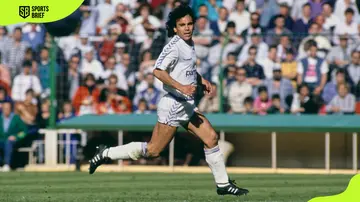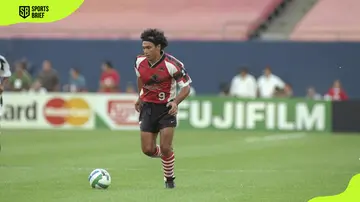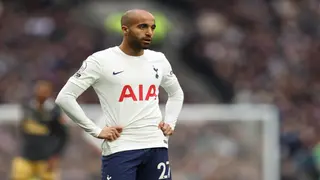Alex Telles' net worth, salary, age, stats, house, cars, contract and more
Football
Hugo Sanchez is a Mexican former professional footballer who played as a forward. Sanchez was one of the best strikers in the 80s, winning a total of five 'Pichichi' trophies that are normally given to players who scored the most goals in a single La Liga season. This article discusses Hugo's exceptional career and everything he achieved.

Sanchez started his career in his native Mexico with the collegiate side U.N.A.M and had spells in Spain and North America. He spent his peak years in Spain with Atletico Madrid and Real Madrid, winning multiple individual and team accolades. Upon his retirement from playing, he went into coaching.
Name | Hugo Sánchez Márquez |
Date of birth | 11 July 1958 |
Place of birth | Mexico City, Mexico |
Nationality | Mexican |
Age | 65 as of January 2024 |
Hair color | Black |
Height in feet | 5ft9 |
Height in centimetres | 174 cm |
Profession | Professional footballer, Sports broadcaster |
Playing career period | 1976-1997 |
National team appearances | 58 |
National team goals | 29 |
Teams played for | UNAM San Diego Sockers Atletico Madrid Real Madrid América Rayo Vallecano Atlante Linz FC Dallas Atlético Celaya |
Coaching Career | U.N.A.M Mexico men's national team Almeria Necaxa Pachuca |
Marital status | Married |
Spouse | Isabel Sanchez |
Children | Three |
Place of residence | Mexico City, Mexico |
Social media | |
Net Worth | $15 million |
Alex Telles' net worth, salary, age, stats, house, cars, contract and more
Football
Hugo Sanchez (aged 65 as of January 2024) was born on 11th July 1958. Sanchez was born in Mexico's capital, Mexico City. His father, Héctor Sánchez, was also a professional footballer who played for the likes of Atlante and Asturias F.C.
Hugo has an estimated net worth of $15 million. This primarily comes from his two decades as a professional footballer. He has also amassed more wealth from his post-playing career, working as a TV football analyst in Mexico. Sanchez has also worked as a FIFA ambassador during several World Cups and has also been featured as a legend in a popular football video game, FIFA 20.

Hugo Sanchez scored many goals in his distinguished career. Here is a breakdown of all of his career stats in all the teams he played for:
Alejandro Garnacho's net worth, salary, age, stats, house, cars, contract
Football
Team | Time period | Goals |
UNAM | 1976-1979 | 97 |
San Diego Sockers | 1979-1980 | 26 |
Atletico Madrid | 1981-1985 | 54 |
Real Madrid | 1985-1992 | 164 |
América | 1992-1993 | 11 |
Rayo Vallecano | 1993-1994 | 16 |
Atlante | 1994-1995 | 13 |
Linz | 1995-1996 | 7 |
F.C Dallas | 1996 | 6 |
Atlético Celaya | 1996-1997 | 2 |
Mexico senior men's national team | 1977-1994 | 29 |
Hugo is a Real Madrid legend and one of Mexico's best players of all time. Many football fans want to learn more about his personal life. Here are some frequently asked questions about Hugo Sanchez:
Sanchez officially retired in 1997 at the age of 39. He did a symbolic retirement game in 1998 for Real Madrid where he touched the ball as a symbol of bowing out of the game. At the time of his retirement, Hugo Sanchez was La Liga's all-time foreign top scorer with 234 goals. His record has since been broken by Lionel Messi and Cristiano Ronaldo.
Fascinating facts about Nemanja Matić's net worth, salary, age, stats, house, cars, contract
Football
Hugo Sanchez has been married twice. With his first wife, Emma Portugal, he had two children, and with his current wife, Isabel Martin, he has another two children. His eldest son, Hugo Sanchez Portugal, followed in his father's footsteps by becoming a professional footballer. In 2014, Hugo Sanchez Portugal passed away in his apartment in Mexico City due to Carbon monoxide poisoning.
After his playing career, Sanchez embarked on coaching by taking over his hometown team, U.N.A.M, in 2000, leading the team to two consecutive championships between 2003 and 2004. He then had a spell in Necaxa before becoming head coach of the Mexican national team in 2006, where he spent two years. He later joined La Liga side Almeria in 2009, assisting the team to avoid relegation from the Spanish top flight.

Fascinating facts about Andreas Christensen's net worth, house, contract, dating, salary, age, stats
Football
During his career, Chaves was known for being an expert marksman. In Spain, he won the top scorer award five times, a feat that was unprecedented at the time. With Real Madrid, he won five consecutive La Liga titles from 1985 to 1990 and the UEFA Cup in 1986. With Mexico, he won the CONCACAF Championship in 1977.
Due to his goalscoring prowess, Sanchez earned the names 'Nino De Oro (The Golden Boy' and Pentapichichi ( five times top scorer). Sanchez was well-loved by fans due to his eccentric style of play and stylish haircuts.
Hugo Sanchez is one of the most prolific strikers in the history of football. The mark he left on football in North America and Spain as a player, coach and ambassador is indelible. Few players can achieve what he did over his career.
Lucas Moura's salary, net worth, bio, and football career
Football
READ MORE: Who are the 10 best La Liga midfielders in the league currently?
Sportsbrief recently detailed the best La Liga midfielders in the league. Midfielders from top sides Barcelona, Atletico Madrid and Real Madrid dominate the list. The likes of Gavi and Bellingham feature prominently on the list.